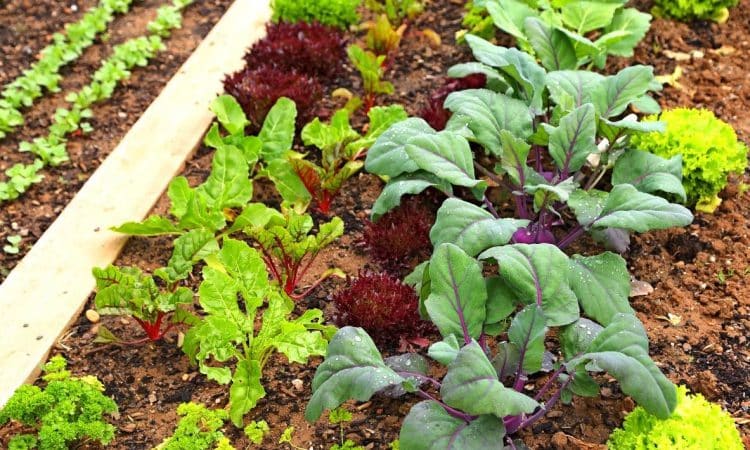4 Ingenious Tips to Protect Your Garden from Heatwaves and Ensure a Generous Harvest, Even in Summer

Heatwaves put our vegetable gardens to the test. In the face of extreme temperatures and intense sunshine, it’s vital to protect our precious vegetables. Here are a few ingenious tips to preserve your crops and guarantee a bountiful harvest, even in the midst of a heatwave.
1. Natural Solutions for a Cool Vegetable Garden
Using natural methods helps create an environment conducive to vegetable growth while limiting the harmful effects of heat. Cascading is a particularly effective technique for optimizing space and protecting the most fragile plants.
This method involves combining different plant species to create a beneficial synergy. For example:
- Plant fruit bushes, corn, or sunflowers to provide natural shade.
- Place more sensitive crops such as lettuces, radishes, and cucumbers in the shade of these taller plants.
- Use lettuces or leeks to protect strawberries from direct sunlight.
This approach allows each plant to play its part in the vegetable garden ecosystem, helping to maintain a favorable thermal balance for all crops. What’s more, this method promotes biodiversity and limits the spread of disease.
To further optimize your vegetable garden, you might ask yourself which vegetables absolutely must be watered every day, especially in hot weather.
2. Plant Protection and Recycled Materials
To enhance your vegetable garden’s protection against excessive heat, it’s a good idea to combine plant-based solutions and recycled materials. Plant screens are a particularly interesting option, combining efficiency and aesthetics.
To create a plant screen:
- Install jute netting between two posts on the most exposed side of the garden.
- Plant climbing species such as beans at the base of the net.
- Let the plants colonize the net to form a natural barrier.
This technique not only protects the crops behind the screen but also produces additional vegetables. Beans, for example, tolerate intense sun and help create a cooler microclimate for the entire vegetable garden.
To complement the plant screen, the use of shade sails can be very effective. There are commercial solutions specially designed for gardening, but for a more ecological and economical approach, simple sheets hung on clotheslines over the vegetable garden can do the trick during hot spells.
3. Improvised Protection Tips
Sometimes, a heatwave can take us by surprise. In such situations, it’s a good idea to be able to react quickly to protect our crops.
Fortunately, many everyday objects can be adapted to create effective temporary sunshades. Here are a few ideas for improvised protection:
| Object | Use | Advantages |
|---|---|---|
| Upside-down crates | Placed over fragile plants | Easy to find, lightweight, airy |
| Old umbrellas | Oriented to shade crops | Adjustable, mobile |
| Cardboard boxes | Placed around plants | Free, biodegradable |
These auxiliary solutions are particularly useful for protecting young plants or species that are more sensitive to sunburn. They enable rapid intervention and can be easily removed when temperatures return to more clement levels.
4. Towards a Vegetable Garden Resilient to Extreme Heat
Protecting our vegetables from heatwaves involves more than just occasional tricks. We need to adopt a global approach to create a resilient vegetable garden, capable of adapting to increasingly frequent climatic variations.
To achieve this, it’s essential to combine the various techniques mentioned above:
- Set up cascading cultivation to optimize space and shade.
- Install plant screens to protect the entire vegetable garden.
- Use shade sails or sheets during hot spells.
- Have improvised protection solutions on hand for emergencies.
In addition, it’s vital to rethink our gardening practices to adapt to climate change. This can include choosing more heat-resistant varieties, adopting energy-efficient watering techniques such as drip irrigation, or using effective mulching to conserve soil moisture.
Finally, let’s not forget that diversity is the key to a robust ecosystem. By encouraging biodiversity in our vegetable garden, we create a more resilient environment, better able to withstand thermal stress. Auxiliary insects, attracted by this diversity, will help maintain the garden’s equilibrium and naturally combat pests that might take advantage of the weakening of plants due to heat.
By adopting these different strategies, we can not only protect our vegetables from the harmful effects of the heatwave but also help to create a more sustainable vegetable garden in harmony with its environment.
In the face of climatic challenges, our ability to adapt and our creativity are our best assets for continuing to grow healthy, tasty vegetables, while preserving water resources.
Main Ideas
- Natural methods: Use cascade cultivation to create a fresh environment and optimize space.
- Plant protection: Install a plant screen with climbing plants to create a natural barrier.
- Improvised solutions: Use everyday objects as temporary sunshades for quick protection.
- Resilient vegetable garden: Combine different techniques and adopt practices adapted to climate change.
- Biodiversity: Encourage species diversity to create a robust ecosystem in the face of thermal stress.

